Sweet Corn
IPM personnel have deployed black light and corn earworm (CEW) pheromone trap networks in central and northern New Jersey counties. As we start our summer field technicians, trap checks are limited. However, even with cool weather and few traps visited, there have been low catches of CEW in several pheromone traps. While this is of little consequence now, it does suggest that local overwintering is a possibility. We have experienced increasing CEW populations in recent years at the time our early plantings silk (mid-June), and the presence of moths in early May points to more of the same this year.
Black light trap derived maps for European corn borer (ECB), CEW and brown marmorated stink bug (BMSB) will not appear in the Plant and Pest Advisory, as there is no statewide blacklight trap network. Data from existing black lights in the central and northern counties will appear in table format, with associated information on the relevance of the populations. Provided that data from the southern CEW pheromone traps is available on a regular basis, maps will be generated for this pest/trap type. Limited collections from traps thus far have not contained any target pests.
Slugs
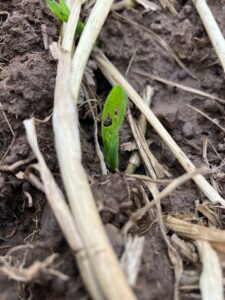 With recent cool wet weather, slug damage (photo at left, by J. Compton) to various crops, including sweet corn has begun to appear. No till or zone till situations give slugs ample hiding places under the surface layer of debris. Plastic mulch can also protect slugs as long as weather remains cool. They are largely active at night but can be found on crop plants anytime conditions are very wet. Most slugs are not as large as the specimen in the picture at right, but even small
With recent cool wet weather, slug damage (photo at left, by J. Compton) to various crops, including sweet corn has begun to appear. No till or zone till situations give slugs ample hiding places under the surface layer of debris. Plastic mulch can also protect slugs as long as weather remains cool. They are largely active at night but can be found on crop plants anytime conditions are very wet. Most slugs are not as large as the specimen in the picture at right, but even small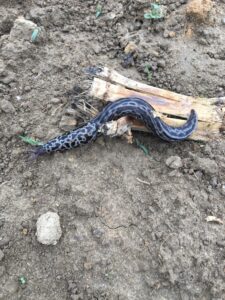 garden slugs can do significant damage to seedlings. Be sure to monitor fields during wet and cool conditions. The presence of slugs and their damage may require an application of slug bait to the affected areas. Various slug baits are available, but labels should be consulted to determine which product is permissible on the affected crop. Check the Pest Management section in the 2024 Commercial Vegetable Production Guide for products.
garden slugs can do significant damage to seedlings. Be sure to monitor fields during wet and cool conditions. The presence of slugs and their damage may require an application of slug bait to the affected areas. Various slug baits are available, but labels should be consulted to determine which product is permissible on the affected crop. Check the Pest Management section in the 2024 Commercial Vegetable Production Guide for products.
Cole crops
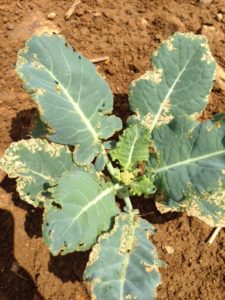 Recently transplanted crops of broccoli, cabbage, etc. as well as newly emerged seedlings are at risk of damage from flea beetles (see photo at left). Flea beetle activity occurs primarily on warm, still days, and the heat during the first half of this week has resulted in threshold levels being reached in several scouted fields. Inspect plantings under these fair conditions to get an accurate assessment of population in the field. Flea beetles can do considerable damage to small plants, and have a
Recently transplanted crops of broccoli, cabbage, etc. as well as newly emerged seedlings are at risk of damage from flea beetles (see photo at left). Flea beetle activity occurs primarily on warm, still days, and the heat during the first half of this week has resulted in threshold levels being reached in several scouted fields. Inspect plantings under these fair conditions to get an accurate assessment of population in the field. Flea beetles can do considerable damage to small plants, and have a 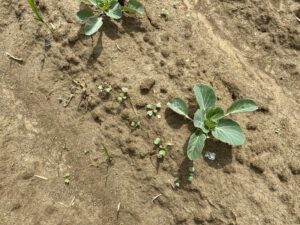 preference for the “hotter” flavored crops like arugula and mustard. They will feed on all brassicas however, and broccoli and Tuscan kale are also favored hosts. Site rotation is critical to managing flea beetle populations because they can build to high numbers in the repeated presence of host crops or host weeds (see photo at right – cabbage transplants with brassica weeds). Scout early and consider treating when 50% or more plants are showing injury and flea beetles are present on plants. Respond quickly to limit injury. Systemic insecticides such as the neonicotinoid (IRAC 4A) class, used at planting, can provide protection from flea beetles for the first critical weeks.
preference for the “hotter” flavored crops like arugula and mustard. They will feed on all brassicas however, and broccoli and Tuscan kale are also favored hosts. Site rotation is critical to managing flea beetle populations because they can build to high numbers in the repeated presence of host crops or host weeds (see photo at right – cabbage transplants with brassica weeds). Scout early and consider treating when 50% or more plants are showing injury and flea beetles are present on plants. Respond quickly to limit injury. Systemic insecticides such as the neonicotinoid (IRAC 4A) class, used at planting, can provide protection from flea beetles for the first critical weeks.
Low numbers of imported cabbage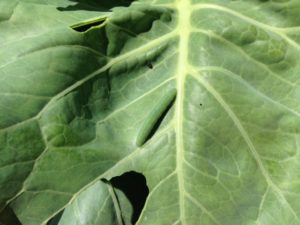 worm (ICW at left) have been discovered in a few cole crop plantings. With warmer temperatures, these infestations could increase rapidly and continue for the duration of the growing season. Imported cabbage worms grow to a length of approximately 1.25” and are covered with short hairs. They are sluggish when disturbed. Check 5 consecutive plants each in 10 random locations throughout the planting, paying particular attention to the innermost leaves where ICW often feed (see photo at lower right). Consider treating if caterpillars are found on 10% or more plants that are in the 0-9 true leaf stage. From 9-leaf to the early head stage (in broccoli, cauliflower, and cabbage) infestations up to 20% may be tolerated. Once heads begin to form, a 5% threshold should be observed to protect the marketable portion of
worm (ICW at left) have been discovered in a few cole crop plantings. With warmer temperatures, these infestations could increase rapidly and continue for the duration of the growing season. Imported cabbage worms grow to a length of approximately 1.25” and are covered with short hairs. They are sluggish when disturbed. Check 5 consecutive plants each in 10 random locations throughout the planting, paying particular attention to the innermost leaves where ICW often feed (see photo at lower right). Consider treating if caterpillars are found on 10% or more plants that are in the 0-9 true leaf stage. From 9-leaf to the early head stage (in broccoli, cauliflower, and cabbage) infestations up to 20% may be tolerated. Once heads begin to form, a 5% threshold should be observed to protect the marketable portion of 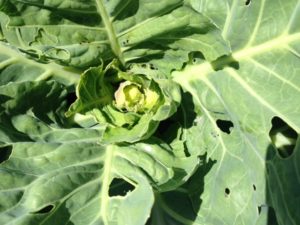 the plant. For leafy greens such as collards and kale, 10% plants infested is the threshold throughout.
the plant. For leafy greens such as collards and kale, 10% plants infested is the threshold throughout.
Diamondback moth larvae (DBM) are increasing slowly in fields in central and northern NJ counties now. Larval numbers are low, but pheromone traps placed in some fields are returning upwards of 30 DBM adults per night. Remember that some populations of DBM are resistant to carbamate and synthetic pyrethroid insecticides. The lack of DBM control with these insecticides has been noted in NJ previously. It is important to distinguish between common cole crop pests for this reason. DBM larvae grow to a length of approximately 0.5”, and taper toward both ends (see photo at lower right).
 DBM caterpillars thrash violently when disturbed. Some chemistries that specifically target caterpillar pests have been effective against DBM as well as all other caterpillar pests of cole crops. These materials include (active ingredient – trade name (IRAC* code)):
DBM caterpillars thrash violently when disturbed. Some chemistries that specifically target caterpillar pests have been effective against DBM as well as all other caterpillar pests of cole crops. These materials include (active ingredient – trade name (IRAC* code)):
Spinosad/Spinetoram – Entrust/ Radiant (5)
Emamectin benzoate – Proclaim (6)
Tolfenpyrad – Torac (21 a)
Cyantraniliprole – Exirel (28)
There are reports from the field that some growers have had success with Spear-Lep (IRAC 32). Note that this material must be combined with a B.t. based foliar insecticide to allow the toxin to enter the body if the target caterpillar.
The IRAC group 5 insecticide, Entrust, is OMRI approved for organic production. Insecticides based on the soil-inhabiting bacterium Bacilllus thuringiensis (B.t.) may also be effective on caterpillar pests of cole crops. Examples include Xentari and Javelin. It is important to return to treated fields within 24-48 hours to assess the DBM control. If significant numbers of larvae remain, it is an indication that your population may be resistant to the material most recently used. The critical message here is that growers’ spray programs should incorporate as many effective products as possible in rotation. Reliance on 1-2 active ingredients could result in the development of resistance to those materials.

